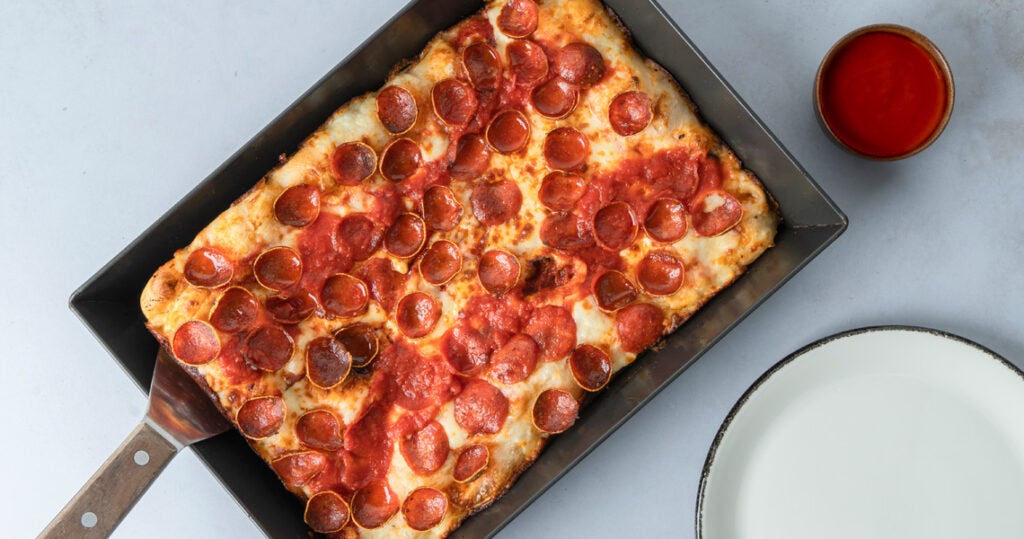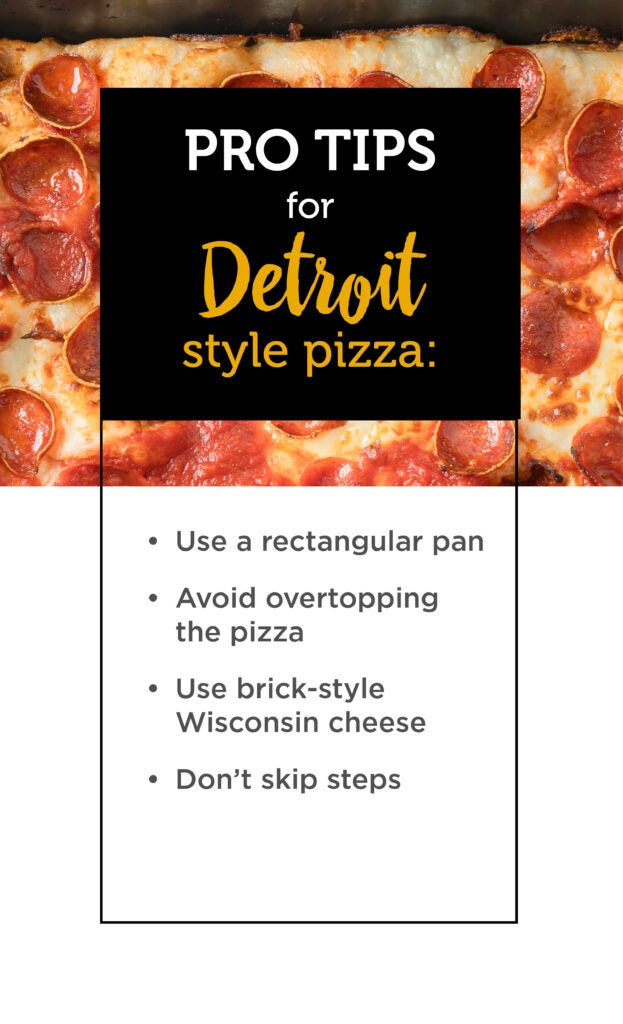The buttery, crispy crust and caramelized cheese corners of a Detroit-style pizza invokes pure
joy for the lucky person noshing on the satisfying square.
The thick layers of bright red sauce and the brick-style Wisconsin cheese set it apart from all the
others that came before it. And the history behind the distinctive pizza is as rich as the pizza
itself.
The Crust on the Famous Pizza Began With a Parts Pan
The rectangular pan that created the masterpiece dates back nearly 80 years to Detroit’s bustling automotive industry. The year the now-famous pizza emerged was at the start of Detroit’s Golden Age of Automotive Design which ran from 1946-1973.
So it should be no surprise that the first pan Chef August “Gus” Guerra, owner of Buddy’s Rendezvous, used to knead that first batch of dough was in a repurposed steel automotive pan. The establishment, later named Buddy’s Pizza, had started out as a tavern experimenting with pizza preparation as part of an expansion.
Guerra was instantly on to something when that first crispy-crusted pizza came out of the oven, said Gordon Food Service® Corporate Executive Chef Kurt Kwiatkowski.
It was a hit then and continues to be.
“Its unique texture and flavour profile has contributed to its growing popularity,” he said.
Out of Order: Detroit-Style Doesn’t Happen ‘Sauce First’
Pizza emerged as a favorite after World War II. The rectangular-shaped pizza was born in
Michigan out of “ingenuity and necessity,” Kwiatkowski explains. The pans were given to
Buddy’s Pizza by a local auto plant that was using them to hold and transport small auto parts.
When Guerra created that first pizza, he chose to sprinkle Wisconsin brick cheese on top of the
dough and doused the sauce as the finish, rather than the base. And that’s what first made it so
unique, Kwiatkowski said.
Creating a Detroit-style pizza using that same process is simple once an operator has the steps
down. One thing Kwiatowski suggests to keep in mind, however, is to not to “overtop” the pizza.
”The centre won’t cook up correctly and you will have a doughy bite that is not very appealing,”
he said.
Also keeping the rest of the steps in order does matter, he said, if you want a true Detroit-style
outcome.
“Flip the order of how the toppings are put on. It starts by first making the dough and letting it
ferment and proof, then stretching the dough into an oiled pan and letting it proof again for a
short period,” he said.
Proofing more than once makes the dough “lighter and a little more flavourful,” he said.
“It is then restretched if needed and then the toppings are put on, followed by the specialty brick
cheese from Wisconsin and topped with sauce.”
The dough develops the distinct, crispy crust due to the high-fat content of the Wisconsin
cheese that seeped throughout the pie.
“The dough is not super heavy either, so it doesn’t sit in your gut like a brick,” Kwiatowski adds.
Operators can add various toppings to mix things up, but one thing should remain consistent, he
advises:
“Just make sure the cheese and toppings go all the way to the edge– that’s a mandatory step.”
Detroit-Style Pizza Remains Trendy, Rising in Popularity
The pan-style pizza was voted #1 in the world back in 2012 at the International Pizza Expo in
Las Vegas. And since then there have been numerous chefs at the same expo awarded for their
version of Detroit-style pizza, according to Forbes.
“With the rise of social media and food trends, Detroit-style pizza has experienced a resurgence
in popularity, gaining attention from pizza enthusiasts and chefs around the world,” Kwiatkowski
said.
Thrillist noted in a 2022 blog post that Detroit-style pizza was “everywhere.” Now nearly two
years later, the love affair with that Detroit-style pie hasn’t fizzled.
There has been plenty of buzz about it on the internet which helps word travel fast. Social media
has certainly fueled the trend, Kwiatkowski notes.
“(It) helped the rise of this style of pizza, even popping up in places like Chicago and New York
where they have a traditional style of pizza already,” he said. “It’s very photo worthy, packs a lot
of flavour and different textures. Once you have the technique down it is easy to reproduce it
consistently.”


























